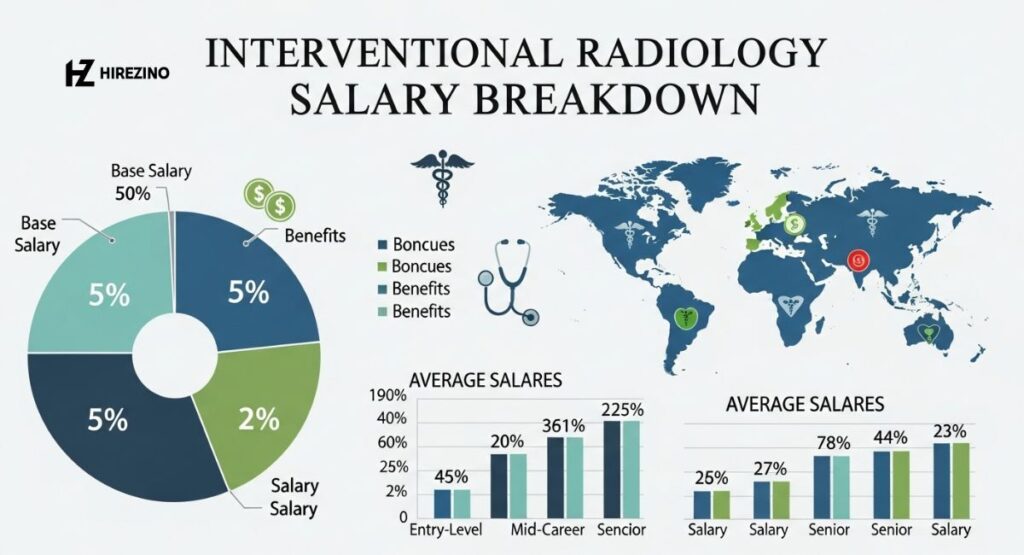interventional radiology salary,I would not only listen to the presentations about their own work, but I also sit and listen to their lunch-hour discussions of challenging clinical cases.” Interventional radiology pay has become one of the hot topics in U.S. healthcare with needs for professionals seeking careers in this space growing >50%. This field of medicine combines imaging with minimally invasive therapies to treat challenging conditions without surgery. With hospitals and universities vying for talented professionals, the apparent worth of this specialty is evident in a financially rewarding income potential that helps shape today’s interventional radiology salary.
With the increasing divide among regions, experience and practice type in 2025 understanding the interventional radiology salary has never been more critical. There are some who love private practice, but there are equally others who prefer the security and opportunities that academics/hospitals present. Beyond the stats, what is so striking about these salary figures is how technological advancement, patient demand and the changing face of healthcare reform have propelled this career into one of the most cutting edge and high-paying medical professions in our current healthcare system.
What Does an Interventional Radiologist Do?

A Radiology specialist with additional training in minimally invasive procedures uses imaging guidance, such as fluoroscopy, CT and ultrasound to direct the treatments inside the body. These specialists provide care for collapsed arteries, tumors and organ conditions without open surgeries. These abilities account for the high interventional radiology salary many professionals receive in the U.S.
Demand for these medical field demand specialits is increasing as patients and hospitals favor minimally invasive procedures. By combining artificial intelligence-guided imaging with robotic prompted interventions their efficacy has never been higher, and this explains the growing compensation for interventional radiology which plays such a critical role in WEMS as we know it today.
How Much Does an Interventional Radiologist Make in 2025?
2025 Average interventional radiology salary The national average salary for a Interventional Radiologist is $400,000 in United States per year and between 400.000 and 550.000 depending on the states location for their clinical practice however it varies across USA and also depends. The work-complicated nature and the growing demand in hospitals and other academic establishment; are incorporated in this salary range (400,000-550,000).
| Experience Level | Average Annual Pay | Work Setting |
| Entry-Level | $380,000 | Hospital/Academic |
| Mid-Level | $450,000 | Hybrid Practice |
| Senior-Level | $540,000+ | Private Practice |
What Are interventional radiology salary? interventional radiology salary (High Earning Jobs) Among the highest earning radiology jobs is that of an interventional radiologist. Private practice radiologist pay is commonly higher than that of working in a hospital, but learning and publishing incentives exist at academic institutions which makes total compensation packages much more equal.
Interventional Radiologist Salary by Experience Level
An interventional radiologist’s experience level greatly determines pay. A newly certified physician may start at around $380,000, while a senior Radiology specialist in private practice often earns over $550,000 annually. Many hospitals now offer a signing bonus or student loan repayment to attract top talent due to fierce interventional radiology job market competition.
Veterans in this field enjoy additional income through locum tenens assignments, which can increase annual earnings significantly. These flexible positions allow radiologists to work short contracts in high-demand states while maintaining professional freedom—an appealing option for those seeking both balance and higher interventional radiology compensation.
Interventional Radiologist Salary by State and City
Earnings vary dramatically across regions due to geographic disparities and radiology salary by location. The states leading the pack are those with large populations like California, New York and Texas, but there are surprises such as smaller Wisconsin and Oregon where competitive offers market physician shortages.
| State | Average Annual Pay | Cost of Living Index | Top-Paying City |
| California | $560,000 | High | San Francisco |
| Texas | $520,000 | Medium | Houston |
| Florida | $490,000 | Medium | Miami |
| New York | $550,000 | High | New York City |
| Wisconsin | $510,000 | Low | Madison |
These highest paying cities for radiologists illustrate that how much do interventional radiologists make by state is often proportional to patient population and the existence of sophisticated medical centers. Rural hospitals by 2025 are offering relocation incentives and signing bonuses to help close gender pay equity and rural urban gaps.
Factors That Affect Interventional Radiologist Salaries
Several factors affect the interventional radiology salary in the US. These include: technological advances capital cost, regional health care budgets and the academic versus private practice salary structure ratio.Hospitals investing in more advanced AI-enabled imaging and robotic-assisted procedures do tend to recruit higher paid specialists.
Other factors include gender pay gap in radiology, hours worked, and subfield focus. Male doctors are still, on average, making somewhat more than female ones, but trends toward pay equity have taken hold. Interventional Radiology compensation is part of comprehensive packages including health insurance benefits, retirement plans and student loan repayment.
Subspecialties and Their Earning Potential
Various sub-specialities in this area contribute to salary differences. Neuro-interventional radiology salary is at the top of the list, Since it is such a specialty field, Interventional radiologist salary falls among the highest when it comes to interventional radiology.
| Subspecialty | Average Annual Pay | Notes |
| Neurointerventional Radiology | $580,000 | Highest risk and precision |
| Oncology Interventional Radiology | $530,000 | Growing cancer treatment demand |
| Pediatric Interventional Radiology | $480,000 | Specialized pediatric care |
Such subspecialty income variances reinforce the value of a narrow focus. Training in subspecialties has the potential both to raise income and enhance career opportunities in the dynamic U.S. health care system.
Job Outlook and Growth in Interventional Radiology
On the job outlook for interventional radiology is still very high. The 2025 demand for interventional radiologists is projected to increase by 12% due to aging of the population as well as increased utilization of less invasive procedures. Hospitals and outpatient centers throughout the country are vying for these specialists to cut recovery times (and costs) with minimally invasive surgery.
This potential is consistent with salary growth in interventional radiology driven by trends in overall IR employment. With the ongoing improvements in technology, accuracy being further increased and demand for qualified Solid Radiology continues expand.
Benefits Beyond Base Pay

Besides the attractive interventional radiology salary there are numerous benefits that professionals with this specialty receive. These amenities must in themselves translate as base pay since they are the icing on a cake which already includes bonuses, retirement and health plans –to make that much more sweet. Additionally, some schools will offer assistance to repay student loans or help you move.
Other perks such as opportunity grants that pay for private lessons and conference support reinforce a culture of life-long learning. Prospective interventional radiology works numbers such as these and perks like those mentioned above are indicative that the industry has recognized the challenging work performed by specialists, including a dearth of knowledge in the category and excellent experience with being an integral part for U.S. healthcare power structure.
How to Become an Interventional Radiologist
It takes time and effort to become an interventional radiologist. The track leads through four years of medical school, five years of residency in diagnostic imaging and one to two years of fellowship. Though demanding, this journey leads to a rewarding medical specialist salary growth that justifies the investment.
New graduates entering the interventional radiology job market often find multiple career opportunities due to increasing demand. With persistence and skill, the return on education through a high interventional radiology salary becomes a long-term professional advantage in the competitive U.S. healthcare system.
Top Paying Related Jobs in Interventional Radiology
Some roles within radiology rival the interventional radiology salary. For instance, diagnostic radiologists, vascular surgeons, and neurointerventional specialists command similarly high pay due to their expertise and risk levels.
| Related Job | Average Annual Salary | Role Comparison |
| Diagnostic Radiologist | $470,000 | Imaging-focused, fewer procedures |
| Vascular Surgeon | $510,000 | Surgical alternative to IR |
| Neurointerventional Specialist | $580,000 | High-demand subspecialty |
This radiology salary comparison is essential for new doctors to find the most rewarding locations in medicine. This mix of innovation, income and the ability to make a difference in people’s lives is what makes interventional radiology attractive to many.
Is Interventional Radiology a Good Career Choice?
Interventional radiology provides great pay, flexibility and ongoing demand in the medical field financial and personal satisfaction. The high-paying jobs in radiology added to the opportunity for meaningful interactions with dozens of patients daily, and it made a perfect career goal for want-to-be doctors.
Despite the long years of training and, every now and then, an overnight shift, the pleasure that comes from changing someone’s life with a minimally invasive process is greater than the difficulty. Interventional radiology salary and career potential continue to be among the strongest of all medical specialties.
Interventional Radiologist Salary Trends and Future Predictions
Radiology salaries are projected to rise for the next 10 years. Given the continual advances in technology and health care, it is expected that salaries will increase further. The interventional radiology salary structure is changing as private groups vie with hospitals for talent.
In the longer term, earnings will be influenced by AI-based imaging and robotic assisted procedures. The interventional radiology salary of the future will be contingent upon not just technical proficiency, but adaptability and ingenuity—two characteristics that are imperative in a constantly evolving U.S. health system.
Conclusion
Becoming an interventional radiologist is a difficult but well-compensated and fulfilling path.From pay perks that exceed base pay to the pride of impacting patient results, it’s a pillar of modern medicine. Interve I The more money that interventional radiology salary makes, the more punch and purpose people have behind their life as a result of it.
Furthermore, the future of interventional radiology holds even more potential for expansion and evolution. The #IRad salary and lifestyle, however, is anticipated to grow with other fields in medicine as technology, such as AI-reconstructed imaging (b) and robotic assisted procedures (c), redefines precision and safety on behalf of the patient. This changing dynamic not only flourishes with technical expertise but also thrives with the implementation of catastrophe learning, adding to what is effectively a thrilling time for ambitious healthcare workers poised to shape modern medicine.
FaQs
What is the highest paid type of radiologist?
The highest paid type of radiologist is the neurointerventional radiologist, known for performing complex brain and spine procedures.
How hard is it to get into interventional radiology?
Getting into interventional radiology is very competitive due to limited residency spots and the field’s high technical skill requirements.
How much does an Interventional Radiologist make in Maryland?
An Interventional Radiologist in Maryland earns an average salary of around $520,000 per year, depending on experience and setting.
Does IR or DR make more?
Interventional radiologists (IR) typically earn more than diagnostic radiologists (DR) because of their procedural workload and specialized expertise.
What is the lowest paid doctor?
The lowest paid doctors are often primary care physicians, such as family medicine or pediatrics specialists, earning much less than procedural fields.
How long is IR residency?
An interventional radiology residency usually takes about six to seven years, including both diagnostic and interventional training.
Meta Description
Explore the real interventional radiology salary across the United States—uncover pay gaps, career trends, and earning insights today.

